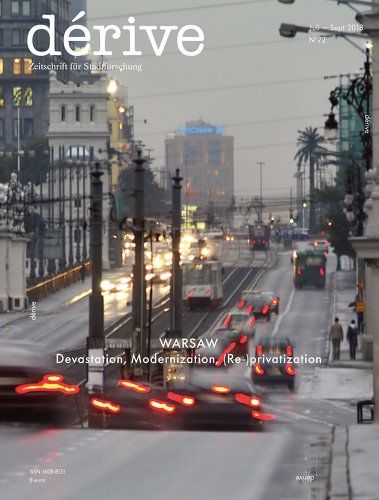Editorial
This special issue on Warsaw is the 72nd edition of dérive and the first with an editorial in English for 18 years (the German version is available on our website, derive.at). In addition to the editorial, all contributions to the focal point are in English. However, this does not mean that dérive will be available only in English in the future. The choice of language is due to the issue being produced in cooperation with the organizers of this year’s INURA conference in Warsaw, where the magazine will also be the conference reader. INURA (International Network for Urban Research and Action) is a network of international urban researchers and activists of which dérive has been a member for many years. Every year a conference takes place in a different city and is conceptualized and organized by the local INURA members. I would like to thank Kacper Pobłocki in particular for the great cooperation on the editorial work for this Warsaw issue. Kacper is not only responsible for the editorial concept, but was also – despite the time-consuming preparation for the conference – involved in the production of the issue from the initial idea to printing.
Warsaw is a city that has experienced radical breaks in its development over the last century, which are still relevant and visible in many different ways today: the Nazi occupation, the crushing of the Warsaw Ghetto Uprising and the subsequent systematic and almost complete destruction of the city can hardly be surpassed in terms of cruel contempt for humanity. Several articles in the focal point refer to these events and their consequences, most directly a text by Bolesław Bierut from 1955, which Irena Maryniak has translated – along with others – from Polish to English for this edition of dérive.
The second major break in Warsaw’s recent urban history saw the shift from a state-socialist to capitalist system. Thereafter, the significance of property grew enormously and profit-oriented thinking made a decisive breakthrough, having a fatal effect on today’s housing market. This makes the ownership of many houses and properties a hotly contested topic, especially in connection with the (re-)privatization of property originally stolen by the Nazis. Of course, most of the buildings affected were destroyed at the end of World War II and, in many cases, the property claims pursued today have nothing to do with the original owners or their descendants. There are cases, for example, where the companies that had real estate confiscated by the National Socialists are revived simply in order to construct a claim for compensation. In the recent past, this topic has caused a stir in the media in Warsaw. Łukasz Drozda analyses the associated debate as played out in current publications. In an interview, activists of the Warsaw Tenants Association (WSL) report on the everyday and concrete effects of conflicts concerning the Warsaw housing market, which have repeatedly turned violent. In addition to the 1955 text by Bolesław Bierut, we have two further manifesto-like texts from other periods. The architects and urban planners Jan Chmielewski and Szymon Syrkus published Warsaw as a Functional City in 1934. Meanwhile, in 2006, Bohdan Jałowiecki considered whether Warsaw is in danger of becoming a Third World city.
Taken together, the three texts provide a range of reflections about the fate of Warsaw and its development through time, thus documenting various historical perspectives.
Three interviews with urban activists complement these texts. In addition to the conversation with the WSL housing activists, dérive spoke to representatives of the Open Jazdów Initiative, an organization that is determined to save a very central park-like site, and the activities that have developed there, from valorisation. The third interview is about the highly active urban grassroots movement that has established itself in Polish cities.
Chaos is a term widely used in discussions about the status of Warsaw. Joanna Kusiak focuses in her article on what the word chaos describes, how it is used, by whom and what it is meant to obfuscate. She traces an arc from Hegel to Harvey, from everyday experiences in Warsaw to the unbuilt Museum of Modern Art, and from a heterogeneous cityscape to neoliberal shock therapy.
Kacper Pobłocki has not only written an introduction to the focal point. In his contribution Salon: Domestication of Warsaw’s Public Space, Pobłocki writes about the relationship of the capital to the rest of the country, about the dominant role of the gentry in urban (class) society and how they have inscribed themselves on Warsaw’s buildings (amounting to a literal gentryfication) and, to conclude, about the function and use of public and private space between salon and socialization.
Finally, a look at the 9th urbanize! festival which will be hosted in two cities for the second time, combining theory, best practice and hands on workshops. urbanize! takes place in Berlin from 5 to 14 October and is organized collectively by a broad alliance of Berlin’s urban movements and housing initiatives in cooperation with dérive. In Vienna urbanize! will take place from 24 to 28 October at Nordbahnhalle, taking a close look at the scale of the neighborhood and its potential for citizens empowerment. Program details will be available from August on www.urbanize.at. You are welcome to join! Save the date(s)!
Our crowdlending campaign is still running for the Viennese Habitat/Mietshäusersyndikat house project Bikes and Rails, where dérive is also involved. We recently surpassed the 200,000 euro mark, which is a great success. But don’t worry, we need another 1.3 million euro. So you still have the opportunity to participate. Information is available at bikesandrails.org.
